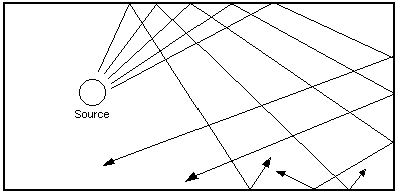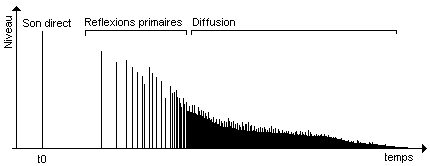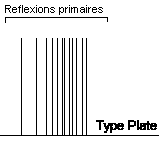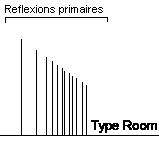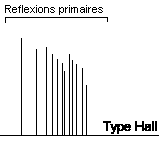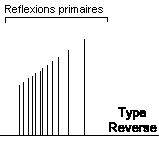You're here : Plug-ins >Learning
Introduction
The reverberation of a sound (also called "room effect") is the result of the sound's interaction with its diffusion environment. In other words, the sound will be different depending on where it is given forth and listened to. You can for example do the experience with a tambourine. Try it in all the rooms of the house, from the bathroom to the garage, crossing the garden... The sound changes, its timbre and its duration too. Well, it's funny.
In fact, a sound has to be considered as an array of acoustic rays that go in all possible directions. The rays are then reflected, absorbed, refracted, depending on the nature of the bodies (solid, gaseous, liquid) they meet on their trajectory. If the sound doesn't come across an obstacle or a change in the ambient environment (a warm air stream in a cold room for instance), there won't be any reverberation. It's almost the case with open field sound system, or in an anechoic chamber.
The Reverb
The goal of a reverberation effect is to simulate a room effect, to recreate the sonic ambience of a more or less known environment : small room, train station hall, church, concert hall, etc... However, these reverberation effects are often used for different objective uses : thickening a sound, giving it some space depth, putting it in front, masking defects, drowning it, giving colour... Each and every user has a precise idea about what is a reverb, and that's what make it a special plug-in. It can almost be compared to an instrument, in the way that each reverb owns an unique colour, an unique behaviour.
The fact that there is no norms, no standards... leads to a consequent variety of effects, all grouped under the denomination "reverb". It seems then quite difficult to do an objective study of the different products on the market. There will always be a specific use in which the qualities and defaults of a product will come through.
However, to stay in the general direction of using the reverberation effect for what it is supposed to do, that is recreating a room ambience, we somehow have to compare it to the facts. The comparison is to be done against a real concert hall, a cathedral, an open garden, etc... And I invite you to wander in reverberating places so that you can hear it for yourself. Thus the choice of a reverberation effect becomes restrictive and difficult., as regards to the conditions of use in one hand, and to the ear on the other hand, which has a natural propensity for getting accustomed to mediocrity.
Quality of a digital reverberation
This graph shows the volume curve of a reverberated Dirac peak impulsion. A Dirac impulsion is a very short sound, of which the length is in theory only one sample long at time t0, where its value is maximum. That peak is represented as the first bar on the graph (t0). When the sound peak passes through a natural or digital reverberation the result above is obtained. The early reflections (or echoes) can be clearly seen; they form the series of distinct lines following the peak. The rest of the curve represents the densification of the reflections, called diffusion. The strength of the phenomenon decays over time, until the total loss of acoustic energy.
To simulate a reverberation effect in the digital realm, we thus have to create a series of echoes that will be densified over time, all the while decaying in volume. A reverb that doesn't densify the sound is of a bad quality, or maybe it's simply an echo, multi-echo or multi-tap effect. To make your mind on this phenomenon, you can try your favorite reverb with percussive sounds (short sound with a strong attack). Let one or two seconds go between each blow and then listen closely to the whole sound reverberating. It's one of the only objective tests one can do to judge a reverberation. However, though this test is necessary, it's not enough to determine the quality of a particular effect.
In fact, a reverb is not only a succession of echoes. On more, the behaviour is not the same with an impulsion (as shown on the last graph) and a continuous sound, such as a musical piece (a full audio track with bass, drums, flute, guitar, piano, voices, etc.). It's not the same either with low frequencies and high frequencies. In brief, it gets complicated.
To show this complexity, let's use the case of a church and a cathedral that would be 100 times greater than the church. These buildings are usually made of stone, therefore materials that are highly reflective. As you guess the church will give back a generous amount of high frequencies in its reverberation (think of a "ttsssss"). However, if we make the church grow, high frequencies won't get more present, they will tend to do just the contrary. Why ? It's because high frequencies are not very energetic when compared to low frequencies. Consequently, the distance to travel before meeting an obstacle gets too long for high frequencies, which have lost a lot of energy getting there, bumping through the molecules of air before arriving to the wall.
The examples of that kind are numerous, and foreshadow a complete and complex interaction between all parameters of a reverberation. It's the way the effect creators took these interactions into account, that give each reverb its own sound, the natural of it, the coldness or the warmness, the color. What a poem...
Caracterization of a reverberation
We have to understand that a real-time reverberation effect is not really a simulation, it's the simulation of a simulation. I'll explain... When objects are created in 3D video, a texture can be applied to them, and then they can be lighted with a number of spots. Be it for a ray tracing or a ray tracing algorithm, the softwares that can light a 3D object do a simulation of the behaviour of the lights in the 3D scene. In the case of ray tracing, the software simulates the progression of the important light rays and their reflections to calculate the resulting lightning and shadows.
In case of sound, the algorithms of digital reverberations don't simulate the acoustic behaviour of sounds, but rather carry out an optimisation of the simulation process through a highly simplified algorithm. But alas ! It's thus far from the physical phenomenon of reverberation of a sound in a room. This alternate process is opted for because of the enourmous difficulties in putting in relation the physical parameters of a room and the parameters of the simulated effect. So, while we wait for softwares that are able to use the architects' plans as an input parameter in real-time treatment (this can be conceived today, but forget for a real-time treatment on PC), we'll expose the usual parameters used in a simulation.
The broad family of reverbs
Presets are often classified by type, which are essentially defined by the shape of the amplitude curve of the first reflections. That curve is often linear, but sometimes the program ads a "liveness" button that modifies the steepeness. All variations within these types are possible of course, and other classifications could be brought...
PLATE Type
The amplitude curve of the early reflections is, as the name implies, like a plate. This type corresponds well enough to small rooms.
|
|
ROOM Type
The early reflections decay steadily and simulate the reverberation in a somewhat big room, such as a small concert hall for example.
|
|
HALL Type
The decaying of the early reflections is irregular, letting you ears think that there's a complex environment with multiple obstacles. It's better suited to the simulation of train stations and big buildings' interiors.
|
|
REVERSE Type
This was the rage in the 80's; it's usually followed by a GATE. It's very tricky to use this type to simulate a real ambience... Maybe a room coupled with a small room from which the sound is emitted ? |
|
Note : the amplitude curve of the early reflections is not enough to define a PLATE reverb or a ROOM reverb. Others parameters come in play such as the time between the reflections, the type of diffusion, etc...
Parameters of the reverberation effects
Because of the diversity of the algorithms, many parameters can vary from a a software to the other, they cannot easily be standardised. But they might have the same effect on the sound as those described below.
Dry / wet, and mix
The "dry" parameter is usually the gain of the source, and is often called "direct" for a reverberation. The wet parameter is the gain of the effect, that is the reverberated sound. "Direct field" and "reverberated field" are terms that can be used too.
The "dry" and the "wet" can be combined in a single parameter, then called "mix", that controls the balance between the direct and the effect. Though It might be convenient, it's not very realistic. That's because the dosage of the dry and the wet sound contributes to the perception of the listener's position in the simulated room. The farther the listener is, the more the reverberation will be present.to his ears, the reverse being true. However, let's not forget that the reverberated field has a homogenous amplitude over the whole volume of the room. This observed property implies that if the listener moves away from the sound source, the dry sound will be less present but the reverberation (wet sound) amplitude will NOT be higher.
Pre-delay
Pre-delay is the time it takes for the sound to touch the first important obstacles in the room. For exemple, if the first wall to meet is at 10 meters from the source the pre-delay will have a value between 30 and 50 milliseconds. A lot of reverberation effects forget about this parameter and it's unfortunate because it's the only one to have a clear relation to the physical phenomenon that interests us : the room effect.
Early Reflections
When the sound is reflected a first time (that is, at the beginning of the reverberation, when the sound waves meet their first reflecting obstacle), we get of series of first reflections, known as early reflections.
Few softwares let the user control the early reflections, essentially because not everybody can use them appropriately. Unless you have a visual appreciation of these reflections it's almost impossible to treat them correctly. Furthermore, a modification of the early reflections implies modifying the whole of the effect, diffusion included, and this to a degree usually not anticipated by the creator. In one word, you cannot be able to modify only the third reflection, and only this precise one.
Reverb time (or RT)
The reverb time makes it possible to shorten the length of the reverberation, that is to say, normally, to change indirectly the size of the room. One will keep in mind that a modification of that parameter gives as a result an uncontrolled modification of the colour, density, sound texture, essentially because of the technology of the algorithm itself, and the uncapacity to put the parameters of this algorithm in touch with a reverb time without changing the integrity of the sound.The value of this parameter, sometimes indicated into seconds or milliseconds, corresponds to nothing. On more, this parameter makes often it possible to transform a Plate reverb into a Hall reverb and vice versa ; then, the user could believe that he has just to reduce the time of a Hall reverb to obtain a Plate reverb, that is a featured nonsense.
Let's seize the opportunity to talk about Mr Sabine who defined reverb time (I think so) to be the time that takes a reverberated space to loose a certain number of decibels. One talk also about RT60 that is the time taken by a reverberation to loose 60dB, but one could also talk about RT40 or RT20. When such a parameter is implanted in a digital effect, the problem is the perception of that time. That is to say, in certain cases, it is not out of the question that you could perceive a RT40 preset of 5 seconds, for example, less long as an other RT40 of 2 seconds. Besides, this parameter was in the past considered as a sufficient parameter in the building of concert halls or auditoriums. Obviously, it has been quickly noticed that two halls having the same RT60 didn't have of necessity the same acoustic results, the same reverb.
Perception of reverb time is a psycho-acoustic phenomenon, that is to say it depends on subjective parameters. A reverb that is strong in high frequencies would always appeared longer than the same one being cutted above 5 KHz. In permanent sound, you aren't be able to hear the reverb when its level get down 24 dB under the direct signal. So, the most the direct sound will be stronger than the reverberated sound, the less this last one would be perceived as long. Etc, etc...
In short, this parameter will make it possible to you to change the length of the reverb, but it should be manipulated without excess if you want your sound to be coherent and of quality.
Damping
This parameter must be put in connection with the type of used material in the room. The more the materials are reflectable, the less muffled are the reflections. In the opposite direction, the reflections would be more quickly muffled if, for example, the walls of the room are covered up of tissue (absorbing material).
"Damping" could be also assimilated to a frequency of response or to the soften rate of the high frequencies. But in fact, it is more subtle, because "damping" conditions really the absorption rate of the high frequencies in time for the entire reflections of the sound.
The adjustments of this parameter are rather the same for any machines. However, any unit can be assigned to it.
Frequency of response (Freq Rep, Colour, brightness)
It is often about a low-pass filter that is more or less performing, it is set before or after the reverb unit, to give more or less high frequencies.
Use of a digital reverb
As we already told, the reverb effects can be used by different ways and for some very various purposes too. We will forget about the chapter of synthesis or re-synthesis (yes, reverb can also transform the sound), it-s up to you to use your creative imagination...
Use for room simulation
For this type of use, in post-production video or to create ambiant sounds for example, the effect should be handled with discernment by using logic and the properties of sound. Let's imagine that there's a concert in a hall, the listener is just in front of the source of the sound. In this case, the source of the sound must be stronger than the reverberated field... Except if he is at 40 meters away from the flute player, who is depth in the background of the cathedral, not too far from the saloon... Let's keep in mind that the reverberated field can't produce more energy than the direct sound.Reverb is a passive phenomenon, walls, sides and obstacles don't give energy to the sound, they preserve it at the most, a little bit as a capacitor.
Adapt the preset to the place. If the spot is a garage or a saloon, or if it is an open place like a courtyard, a "Train-station Hall" effect will be inappropriated and vice versa, if we have still the purpose to respect the energetical logic of the sound and to adapt the intensity of the reverb in consequence. If two people whisper in a spacious hall, the reverb will be very low because the level of the speech will be very low, thus, this speech will be reverberated very low. On the contrary, a mortar shot in the closing center of the crypt of the basilica St-Pierre de Rome would be "heavily" reverberated. Moreover, one avoids to add the sound effects like this in very reverberatable places like the subway, big train-station halls, etc., by increasing the number of sonorous sources. Some amplifiers are set every 5 meters, for example, and produce a little acoustic power in order to make it possible to the sound to loose a maximum of energy before being reflected, so reverberated.
The use of a reverb effect on an already reverberated sound could be conceived, but only with high-quality effects. One will avoid to use the same preset from a treatment to an another one. As for a work in multitracks, using several different reverbs on the audio tracks could be done only with high-quality machines. On the contrary cases, one will obtain unwished effects like resound, variations of phase, tube effect, distorsion, and sometimes divergence of the signal (that is to say that the volume of the sound increases till a total distorsion and full disapearance.
Moderated use or how to have a big sound
Reverbs give to the sound some frequencies, some harmonics, some sonorous space, some power too. In short, there's a reason why organs are often located in churches, the building is then used as a sound box being a real part of the instrument.
In a lot of cases, a well-choosen reverb improve the quality and the depth of the sound. To do so, discreetly, one will adapt the preset to the sound. The more the sound will be short and agressive (drums, for example), the more one will use a short reverb, and vice versa.A variation on the right and left predelays will make it possible to give more sonorous space, in other words, to "enhance" the final sound.
The purpose is to not be able to distinguish the reverb effect from the original sound.
In mastering
Generally, and except any particular case like making a "live" album from a studio record, the reverbs applicated to the sound are often at a very low level (-12 to -40 dB) compared to the level of the direct sound. This gives beauty to the silent parts and adds insensibly a certain heat and unity to the sound.
Sometimes, an album is treated with a small reverb to unify its sound, and in order to simulate the sonorous ambiance of the room where would have been played the songs.
In conclusion
Digital reverb effects give some satisfying solutions to the ear, in the creation of sonorous spaces and room effects. The quality of these effects depends hardly on the number of the filters used in the algorithm. So, don't be surprised to notice that the best of them request a lot of CPU ressources.
Except the technical part of a reverb effect, that is besides not determinated (that is to say that ther 's no wonder solution, no miraculous algorithm), the quality of a reverb depends on the earsight of the person who adjusted the sounds. This work can't be done in a mathematical way, systematically, it still remains the sensible part when one elaborates a reverb effect. For this reason, a reverb is an instrument, with its own charateristics and its specific colour.
Vincent BUREL, on the 05-04-2000
Page viewed 20738 times

